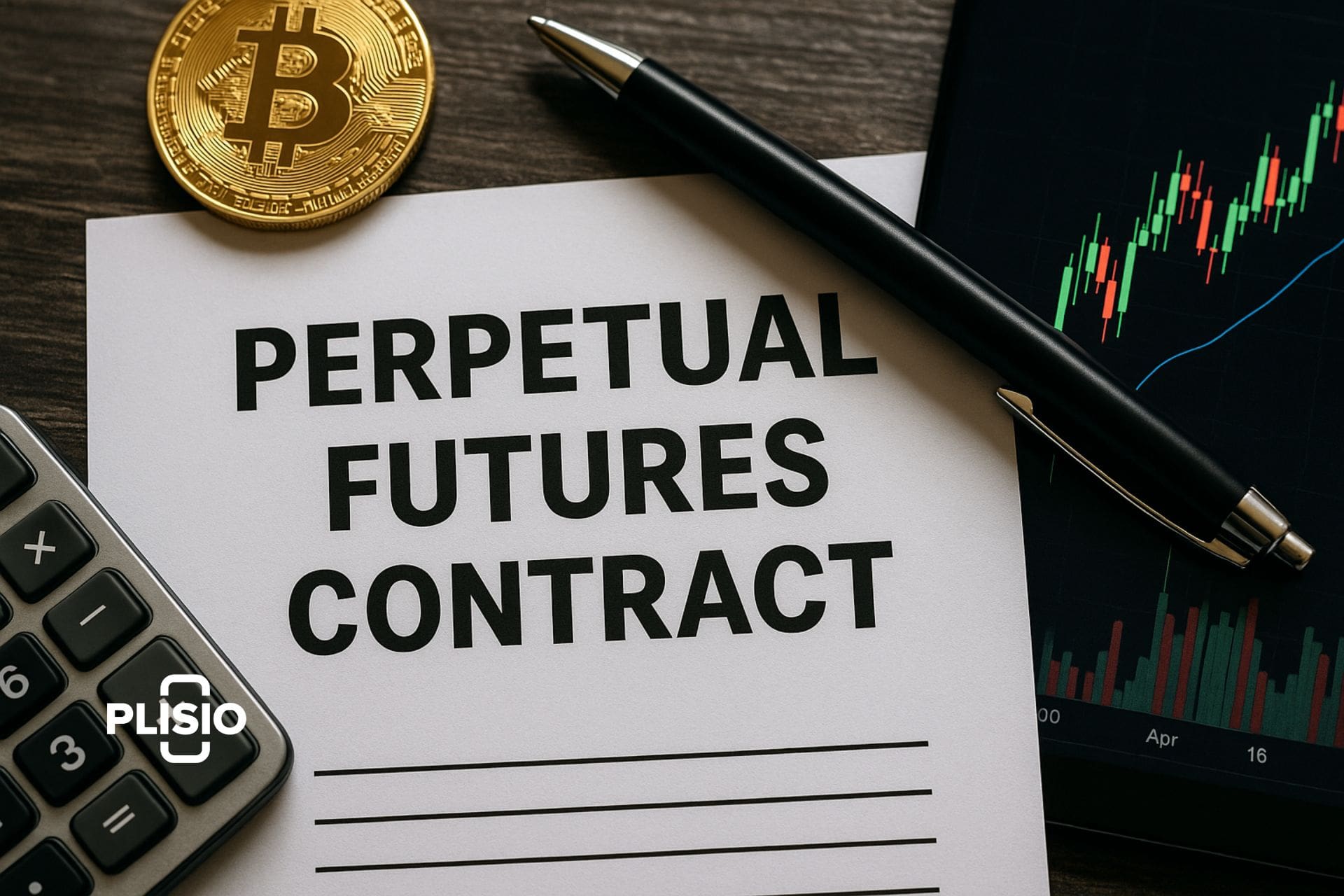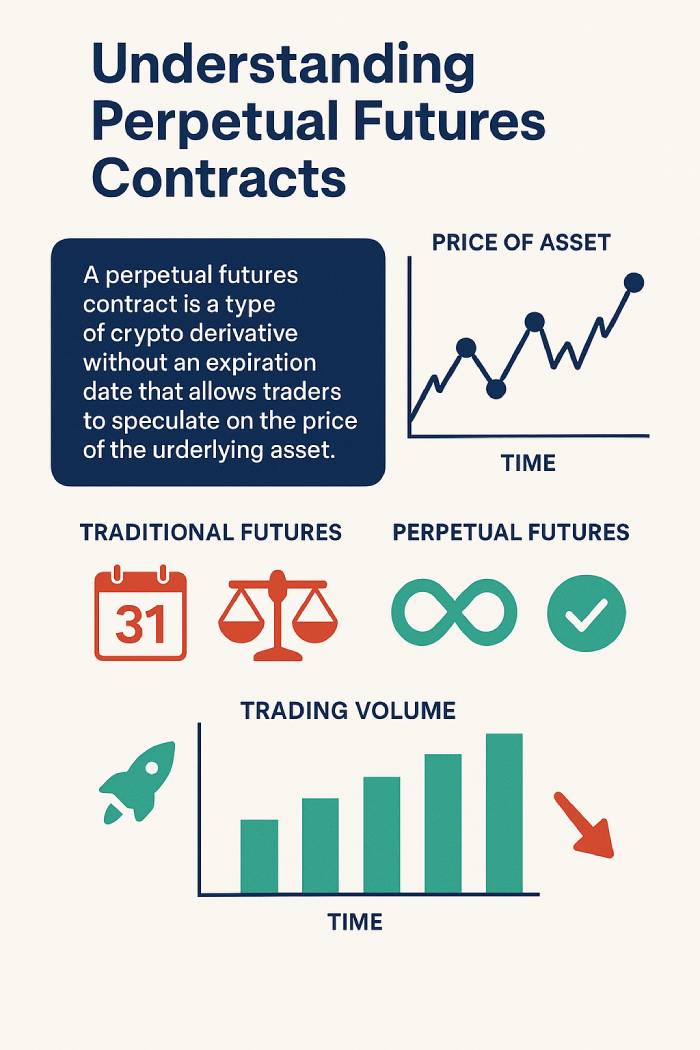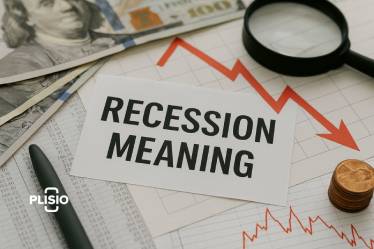What Are Perpetual Futures Contracts?

A perpetual futures contract, also referred to as a perpetual swap, is a crypto derivative that allows traders to speculate on the future price of the underlying asset without owning it or dealing with an expiration date. These instruments have become popular in the cryptocurrency market due to their flexibility and round-the-clock trading availability.
Futures Contracts vs. Perpetual Futures Contracts
Traditional futures contracts are financial agreements that obligate the buyer and seller to exchange an asset at a set price on a specific future date. Historically, these contracts originated in commodity markets, helping buyers and sellers hedge against price volatility. While traditional futures contracts still exist across various markets, they have also evolved into tools for speculation, allowing traders to bet on price movements without any intent to take physical delivery.
Unlike traditional futures, perpetual futures contracts do not have a fixed expiry date. Instead, they rely on a funding rate mechanism to ensure that the price of the perpetual contract stays close to the spot price of the underlying asset. This funding rate is periodically paid between traders depending on market conditions and the difference between the perpetual contract price and the spot market value.
Core Concepts of Perpetual Futures Trading
- No Expiration Date: The lack of a set expiration date means traders can hold a position as long as they maintain margin requirements.
- Funding Rate Mechanism: This mechanism helps maintain parity between the perpetual contract and the underlying asset's spot price. When the perpetual price trades higher than the spot price, long positions pay short positions, and vice versa.
- Leverage: Traders can use leverage to increase their market exposure, amplifying both potential gains and losses.
- 24/7 Crypto Market Access: Unlike many traditional markets, the crypto market operates around the clock, making perpetual futures trading possible at any time.
How Perpetual Contracts Work
Perpetual futures trading begins when a trader opens a long or short position on a trading platform. These contracts derive their price from an index based on the spot price of the underlying crypto asset. Since there’s no expiration date, exchanges use the funding rate model to prevent the contract price from drifting too far from the actual market price.
Key steps include:
- Opening a Position: Traders can speculate on price increases (long) or price decreases (short).
- Price Anchoring: An index price based on spot market data keeps the perpetual price aligned with real-time values.
- Funding Payments: If the perpetual price is above the spot price, the funding rate is positive, and longs pay shorts. If it’s below, shorts pay longs.
- Profit and Loss: Profits or losses are determined by how market prices move relative to the trader’s entry point.
- Liquidation Risk: Using leverage introduces the risk of forced liquidation if the market moves against the trader’s position significantly.
User Experience & Practical Applications
Many crypto traders find perpetual futures ideal for short-term trading strategies. For instance, Hanna K., an active trader on Binance, shares: “I use perpetual futures contracts primarily for hedging. When I hold spot ETH, I sometimes short ETH perpetuals to lock in profit or reduce risk during uncertain conditions. The flexibility is unmatched.”
Another trader, Jake P., prefers high-frequency trading. “I run a bot that opens micro positions on BTC perpetuals when volatility spikes. Because there’s no expiration, I can leave it running without worrying about rollover.”
Even beginners find value with low-leverage use. Community member @CryptoNova posted on a forum: “I started with 2x leverage and small positions. The key is treating leverage carefully — it's easy to get wiped out otherwise.”

Market Evolution and Regulation
Perpetual contracts were first conceptualized in the early 1990s but did not gain traction until the rise of cryptocurrency trading. The first major perpetual futures platforms emerged in 2015, shortly after Bitcoin-based traditional futures contracts became available. Today, perpetual futures dominate trading volume across crypto derivatives markets.
According to Coingecko, the total spot trading volume on the top 10 centralized exchanges in Q1 2025 reached $5.4 trillion, marking a 16.3% decline compared to the previous quarter. Meanwhile, the derivatives market continues to grow, signaling strong interest in leveraged trading tools.
CME Group reported that in April 2025, the average daily volume of crypto derivatives reached 183,000 contracts — a 129% year-over-year increase. Particularly, Ethereum futures saw a 239% surge in volume, highlighting the growing investor demand for altcoin derivatives.
On Binance, perpetual futures remain among the most actively traded instruments. Pairs such as BTC/USDT, ETH/USDT, and SOL/USDT consistently lead the platform’s trading volume, indicating sustained retail and institutional interest in perpetual contracts.
However, unlike commodity futures which are strictly regulated (e.g., by the CFTC in the U.S.), many perpetual futures products are offered by platforms outside regulated jurisdictions. As a result, access to these contracts may be restricted or unavailable to residents in countries with tight regulations.
Expert Opinions
Industry experts generally view perpetual futures contracts as a key innovation in the crypto derivatives space. According to Sarah Jensen, Head of Research at BlockWave Analytics, “The flexibility and liquidity of perpetual futures have made them the go-to instrument for both hedging and speculation in the digital asset space. Their design eliminates settlement pressure while offering real-time exposure to market trends.”
Mark Liu, derivatives strategist at CryptoQuant, adds, “The rise in perpetual contract volumes reflects a broader shift in crypto trading behavior. Institutional players are increasingly adopting perpetuals due to their efficiency and integration with algorithmic trading strategies.”
However, some experts caution against excessive reliance on leverage. Alex Romero, risk manager at BitTrust Capital, warns, “Perpetual futures can be dangerous tools in the hands of inexperienced traders. Leverage amplifies not only gains but losses, and during periods of high volatility, liquidations can cascade rapidly.”
Pros and Cons of Perpetual Futures Contracts
Advantages:
- Enable traders to speculate on crypto price movements without owning the asset.
- No expiry date simplifies trading strategies.
- Funding rate mechanism helps align futures price with the spot price.
- Allows access to leverage in a 24/7 market.
Disadvantages:
- High leverage increases the risk of liquidation.
- Prices may temporarily decouple from the spot market during volatility.
- Lack of regulation in some regions exposes traders to counterparty risk.
Essential Takeaways
- A perpetual futures contract is a derivative product that allows traders to speculate on the future price of the underlying asset without expiration.
- These contracts rely on a funding rate mechanism to track the spot market and balance long and short positions.
- Perpetual futures trading is widely used in the crypto market due to its flexibility, high liquidity, and the ability to use leverage.
- However, due to volatility and limited regulation, they come with significant risks and are not suitable for all trading strategies.
Conclusion
Perpetual futures contracts represent one of the most dynamic instruments in cryptocurrency trading today. By removing the limitation of an expiration date and incorporating a funding rate mechanism, they offer a modern alternative to traditional futures contracts. Still, as with any high-risk financial product, understanding how these contracts work—and how market conditions, funding rates, and leverage interact—is critical. Traders must stay informed, practice sound risk management, and choose reputable trading platforms to navigate the complexities of the perpetual futures market successfully.




